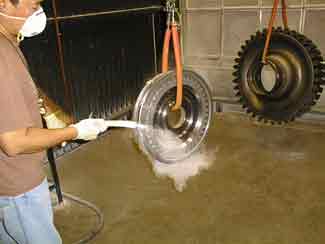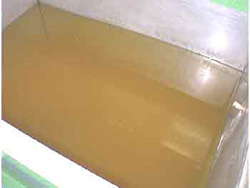
The role of the developer is to pull the trapped penetrant material out of defects and spread it out on the surface of the part so it can be seen by an inspector. The fine developer particles both reflect and refract the incident ultraviolet light, allowing more of it to interact with the penetrant, causing more efficient fluorescence. The developer also allows more light to be emitted through the same mechanism. This is why indications are brighter than the penetrant itself under UV light. Another function that some developers perform is to create a white background so there is a greater degree of contrast between the indication and the surrounding background.
The AMS 2644 and Mil-I-25135 classify developers into six standard forms. These forms are listed below:
The developer classifications are based on the method that the developer is applied. The developer can be applied as a dry powder, or dissolved or suspended in a liquid carrier. Each of the developer forms has advantages and disadvantages.

Dry powder developer is generally considered to be the least sensitive but it is inexpensive to use and easy to apply. Dry developers are white, fluffy powders that can be applied to a thoroughly dry surface in a number of ways. The developer can be applied by dipping parts in a container of developer, or by using a puffer to dust parts with the developer. Parts can also be placed in a dust cabinet where the developer is blown around and allowed to settle on the part. Electrostatic powder spray guns are also available to apply the developer. The goal is to allow the developer to come in contact with the whole inspection area.
Unless the part is electrostatically charged, the powder will only adhere to areas where trapped penetrant has wet the surface of the part. The penetrant will try to wet the surface of the penetrant particle and fill the voids between the particles, which brings more penetrant to the surface of the part where it can be seen. Since dry powder developers only stick to the area where penetrant is present, the dry developer does not provide a uniform white background as the other forms of developers do. Having a uniform light background is very important for a visible inspection to be effective and since dry developers do not provide one, they are seldom used for visible inspections. When a dry developer is used, indications tend to stay bright and sharp since the penetrant has a limited amount of room to spread.

As the name implies, water soluble developers consist of a group of chemicals that are dissolved in water and form a developer layer when the water is evaporated away. The best method for applying water soluble developers is by spraying it on the part. The part can be wet or dry. Dipping, pouring, or brushing the solution on to the surface is sometimes used but these methods are less desirable. Aqueous developers contain wetting agents that cause the solution to function much like dilute hydrophilic emulsifier and can lead to additional removal of entrapped penetrant. Drying is achieved by placing the wet but well drained part in a recirculating, warm air dryer with the temperature held between 70 and 75°F. If the parts are not dried quickly, the indications will will be blurred and indistinct. Properly developed parts will have an even, pale white coating over the entire surface.
Water suspendable developers consist of insoluble developer particles suspended in water. Water suspendable developers require frequent stirring or agitation to keep the particles from settling out of suspension. Water suspendable developers are applied to parts in the same manner as water soluble developers. Parts coated with a water suspendable developer must be forced dried just as parts coated with a water soluble developer are forced dried. The surface of a part coated with a water suspendable developer will have a slightly translucent white coating.

Nonaqueous developers suspend the developer in a volatile solvent and are typically applied with a spray gun. Nonaqueous developers are commonly distributed in aerosol spray cans for portability. The solvent tends to pull penetrant from the indications by solvent action. Since the solvent is highly volatile, forced drying is not required. A nonaqueous developer should be applied to a thoroughly dried part to form a slightly translucent white coating.
Plastic or lacquer developers are special developers that are primarily used when a permanent record of the inspection is required.